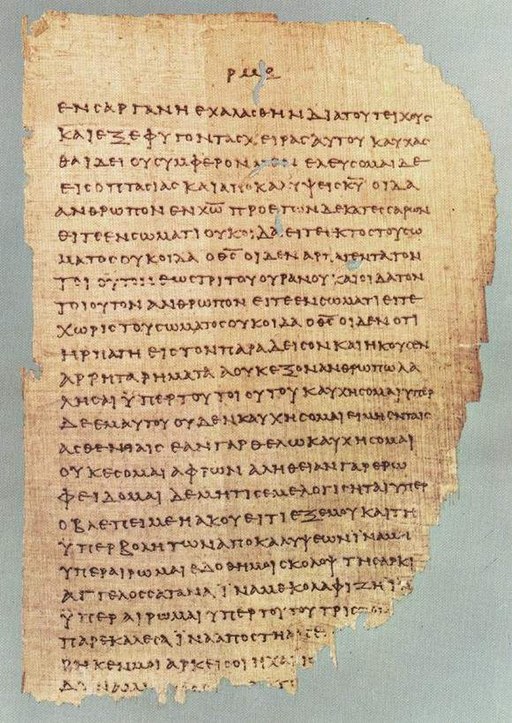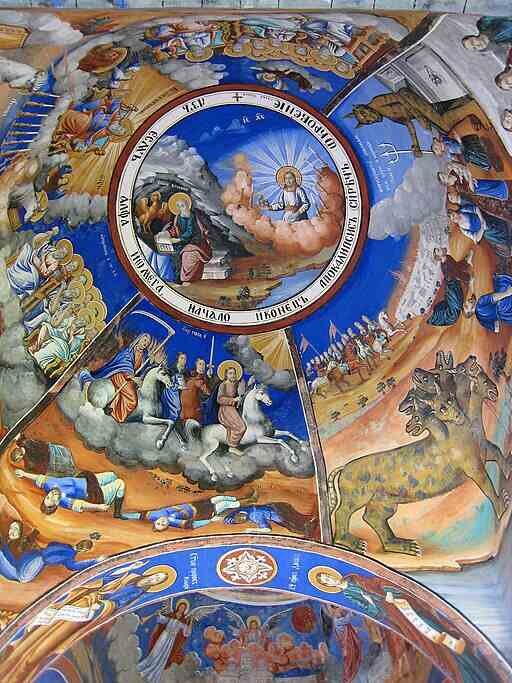Letters of Paul | The Pauline Epistles
The Epistles of Paul or Pauline Epistles or Letters of Paul are a set of 13 letters attributed to the apostle Paul of Tarsus and addressed to different Christian communities of the 1st century. A fourteenth letter, the Epistle to the Hebrews, the work of an anonymous author, is sometimes added to them. They quickly became part of the canon of Scripture. From the end of the first century, most Christian communities used these texts in their liturgy.
The Pauline epistles, also called Epistles of Paul or Letters of Paul, are the thirteen books of the New Testament attributed to Paul the Apostle, although the authorship of some is in dispute. Among these epistles are some of the earliest extant Christian documents. They provide an insight into the beliefs and controversies of early Christianity. As part of the canon of the New Testament, they are foundational texts for both Christian theology and ethics. The Epistle to the Hebrews, although it does not bear his name, was traditionally considered Pauline (although Origen, Tertullian and Hippolytus amongst others, questioned its authorship), but from the 16th century onwards opinion steadily moved against Pauline authorship and few scholars now ascribe it to Paul, mostly because it does not read like any of his other epistles in style and content.
Letters of Paul have a characteristic personal relationship between the writer and recipient of the letter. Paul greeted many people by name and was often affixed with information on the value of their friendship and gratitude for the kindness they gave him.
Most scholars agree that Paul actually wrote seven of the Pauline epistles (Galatians, 1 Corinthians, 2 Corinthians, Romans, Philemon, Philippians, 1 Thessalonians), but that four of the epistles in Paul’s name are pseudepigraphic (Ephesians, First Timothy, Second Timothy, and Titus) and that two other epistles are of questionable authorship (Second Thessalonians and Colossians). According to some scholars, Paul wrote these letters with the help of a secretary, or amanuensis, who would have influenced their style, if not their theological content.
Read also: The Complete Holy Bible
The Pauline epistles are usually placed between the Acts of the Apostles and the Catholic epistles in modern editions. Most Greek manuscripts, however, place the General epistles first, and a few minuscules (175, 325, 336, and 1424) place the Pauline epistles at the end of the New Testament.

The Apostle Paul, by Rembrandt. (1633). Rembrandt, Public domain, via Wikimedia Commons
Exploring the Pauline Epistles: Insights into the Letters of Paul
The Pauline Epistles, a collection of letters attributed to the apostle Paul, form a significant portion of the New Testament. These letters, known for their theological depth and practical guidance, have played a foundational role in shaping Christian doctrine and practice.
Introduction to the Pauline Epistles
Comprising letters to various early Christian communities, the Pauline Epistles include works like Romans, Corinthians (1 and 2), Galatians, Ephesians, Philippians, Colossians, Thessalonians (1 and 2), Timothy (1 and 2), Titus, and Philemon. Each epistle addresses specific issues faced by these communities, offering spiritual counsel and doctrinal insights.
Theological Depth
Paul’s letters delve into profound theological concepts, exploring themes such as justification by faith, grace, redemption, and the role of Christ in salvation. Romans, in particular, stands out for its systematic presentation of these theological principles.
Practical Guidance
Beyond theological discussions, the Pauline Epistles provide practical guidance for Christian living. Topics range from ethical conduct within the Christian community to instructions for communal worship and the virtues of love, faith, and hope.
Personal Insights
Several epistles offer glimpses into Paul’s personal experiences, challenges, and relationships with the communities to which he writes. Philemon, for instance, addresses the issue of a runaway slave named Onesimus, reflecting Paul’s compassion and advocacy for social justice.
Enduring Influence
The enduring influence of the Pauline Epistles is evident in their continuous relevance for contemporary believers. These letters serve as a source of inspiration, offering timeless wisdom and guidance for navigating the complexities of faith and Christian living.
In exploring the Pauline Epistles, readers embark on a journey through the theological richness and practical wisdom encapsulated in the letters of Paul, discovering insights that continue to resonate with believers across the centuries.

Destination of the Pauline epistles: Colossae (Philemon, Colossians), Thessalonica (First Thessalonians, Second Thessalonians), Rome (Romans), Corinth (First Corinthians, Second Corinthians), Galatia (Galatians), Ephesus (Ephesians, First Timothy, Second Timothy) , Philippians (Philippians), Crete (Tite). Emmanuel Roquette, CC BY-SA 4.0, via Wikimedia Commons
In the order they appear in the New Testament, the Letters of Paul are:
| Name | Addressees | Greek | Latin | Abbreviations | ||
|---|---|---|---|---|---|---|
| Full | Min. | |||||
| Romans | Church at Rome | Πρὸς Ῥωμαίους | Epistola ad Romanos | Rom | Ro | |
| 1 Corinthians | Church at Corinth | Πρὸς Κορινθίους Αʹ | Epistola I ad Corinthios | 1 Cor | 1C | |
| 2 Corinthians | Church at Corinth | Πρὸς Κορινθίους Βʹ | Epistola II ad Corinthios | 2 Cor | 2C | |
| Galatians | Church at Galatia | Πρὸς Γαλάτας | Epistola ad Galatas | Gal | G | |
| Ephesians | Church at Ephesus | Πρὸς Ἐφεσίους | Epistola ad Ephesios | Eph | E | |
| Philippians | Church at Philippi | Πρὸς Φιλιππησίους | Epistola ad Philippenses | Phil | Phi | |
| Colossians | Church at Colossae | Πρὸς Κολοσσαεῖς | Epistola ad Colossenses | Col | C | |
| 1 Thessalonians | Church at Thessalonica | Πρὸς Θεσσαλονικεῖς Αʹ | Epistola I ad Thessalonicenses | 1 Thess | 1Th | |
| 2 Thessalonians | Church at Thessalonica | Πρὸς Θεσσαλονικεῖς Βʹ | Epistola II ad Thessalonicenses | 2 Thess | 2Th | |
| 1 Timothy | Saint Timothy | Πρὸς Τιμόθεον Αʹ | Epistola I ad Timotheum | 1 Tim | 1T | |
| 2 Timothy | Saint Timothy | Πρὸς Τιμόθεον Βʹ | Epistola II ad Timotheum | 2 Tim | 2T | |
| Titus | Saint Titus | Πρὸς Τίτον | Epistola ad Titum | Tit | T | |
| Philemon | Saint Philemon | Πρὸς Φιλήμονα | Epistola ad Philemonem | Philem | P | |
Key Message for Each:
- Romans (Rom)
- Important Message: The letter to the Church at Rome addresses foundational Christian theology, emphasizing the righteousness of God, salvation through faith, and the inclusion of both Jews and Gentiles in God’s plan.
- 1 Corinthians (1 Cor)
- Important Message: 1 Corinthians addresses various issues within the Church at Corinth, providing guidance on matters such as unity, moral conduct, spiritual gifts, and the resurrection of the dead.
- 2 Corinthians (2 Cor)
- Important Message: This letter, the second to the Corinthians, contains Paul’s defense of his apostleship and encourages the Corinthians to be generous in giving. It emphasizes reconciliation and perseverance through challenges.
- Galatians (Gal)
- Important Message: Galatians focuses on the freedom found in Christ and strongly opposes legalism. It emphasizes salvation by faith alone and the indwelling of the Holy Spirit.
- Ephesians (Eph)
- Important Message: Ephesians explores the concept of the Church as the body of Christ, unity in diversity, and the spiritual blessings of believers. It calls for holy living and the armor of God.
- Philippians (Phil)
- Important Message: Philippians is a letter of joy and gratitude, encouraging believers to rejoice in all circumstances. It emphasizes humility, unity, and the pursuit of Christ-like character.
- Colossians (Col)
- Important Message: Colossians emphasizes the preeminence of Christ, warning against false teachings. It encourages believers to remain rooted in Christ, practice virtues, and maintain healthy relationships.
- 1 Thessalonians (1 Thess)
- Important Message: 1 Thessalonians focuses on the second coming of Christ, encouraging believers to live in readiness. It provides insights into Christian conduct and offers comfort concerning believers who have died.
- 2 Thessalonians (2 Thess)
- Important Message: Building on 1 Thessalonians, this letter addresses the second coming of Christ, the man of lawlessness, and encourages believers to stand firm in the faith.
- 1 Timothy (1 Tim)
- Important Message: 1 Timothy is a pastoral letter providing guidance to Timothy, focusing on proper church order, leadership qualifications, and practical instructions for Christian living.
- 2 Timothy (2 Tim)
- Important Message: 2 Timothy is a personal letter from Paul to Timothy, emphasizing perseverance in ministry, sound doctrine, and enduring hardship for the sake of the gospel.
- Titus (Tit)
- Important Message: Titus is a pastoral letter addressing church leadership and conduct. It emphasizes the importance of good works, sound doctrine, and the grace of God.
- Philemon (Philem)
- Important Message: Philemon is a personal letter regarding a runaway slave, emphasizing forgiveness, reconciliation, and the transformative power of the gospel in social relationships.
Papyrus 46
Papyrus 46 (P. Chester Beatty II), 𝔓46, is an early Greek New Testament manuscript on papyrus, part of the Chester Beatty Papyri collection. Dated between 175 and 225 CE, or early 3rd century CE, it contains verses from Romans, 1 & 2 Corinthians, Galatians, Ephesians, Colossians, Philippians, 1 Thessalonians, and Hebrews.

A papyrus folio P.46 , containing the passage corresponding to the Second Epistle to the Corinthians 11:33–12:9. The folio has a gap at the bottom. It is a Category I papyrus according to the classification of Kurt Aland and Barbara Aland and was dated to the years 175-225.
The New American Standard Bible (which follows P46 in all but 7 instances, 2 of which are spelling errors in P46) translates the text as follows:
…[and I was let down] in a basket [through a window] in the wall, and so escaped his hands. Boasting is necessary, though it is not profitable; but I will go on to visions and revelations of the Lord. I know a man in Christ who fourteen years ago–whether in the body I do not know, or out of the body I do not know, God knows–such a man was caught up to the third heaven. And I know how such a man–whether in the body or apart from the body I do not know, God knows–was caught up into Paradise and heard inexpressible words, which a man is not permitted to speak. On behalf of such a man I will boast; but on my own behalf I will not boast, except in regard to my weaknesses. For if I do wish to boast I will not be foolish, for I will be speaking the truth; but I refrain from this, so that no one will credit me with more than he sees in me or hears from me. Because of the surpassing greatness of the revelations, for this reason, to keep me from exalting myself, there was given me a thorn in the flesh, a messenger of Satan to torment me–to keep me from exalting myself! Concerning this I implored the Lord three times that it might leave me. And He has said to me, “My grace is sufficient for you, for power [is perfected in weakness ” Most gladly, therefore, I will rather boast about my weaknesses, so that the power of Christ may dwell in me.]
In the King James Version of the Bible this is translated as:
And through a window in a basket was I let down by the wall, and escaped his hands.
It is not expedient for me doubtless to glory. I will come to visions and revelations of the Lord.
I knew a man in Christ above fourteen years ago, (whether in the body, I cannot tell; or whether out of the body, I cannot tell: God knoweth;) such an one caught up to the third heaven. And I knew such a man, (whether in the body, or out of the body, I cannot tell: God knoweth;) How that he was caught up into paradise, and heard unspeakable words, which it is not lawful for a man to utter. Of such an one will I glory: yet of myself I will not glory, but in mine infirmities.
For though I would desire to glory, I shall not be a fool; for I will say the truth: but now I forbear, lest any man should think of me above that which he seeth me to be, or that he heareth of me. And lest I should be exalted above measure through the abundance of the revelations, there was given to me a thorn in the flesh, the messenger of Satan to buffet me, lest I should be exalted above measure.
For this thing I besought the Lord thrice, that it might depart from me. And he said unto me, My grace is sufficient for thee: for my strength is made perfect in weakness. Most gladly therefore will I rather glory in my infirmities, that the power of Christ may rest upon me. University of Michigan, Public domain, via Wikimedia Commons
yes
Sources: Biblica, Bible Study Tools, Wikipedia
Photo credit: Wikimedia Commons
Photo explanations: Saint Paul writing his epistles by Valentin de Boulogne (1618-1620), Museum of Fine Arts, Houston.



